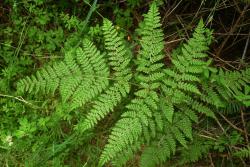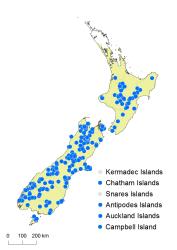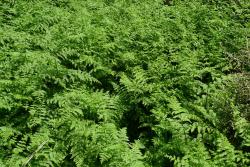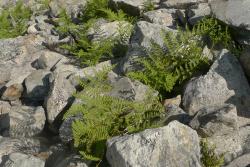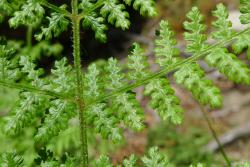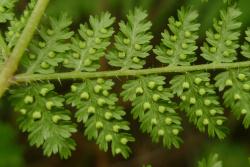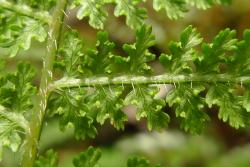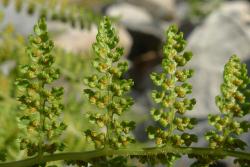Rhizomes long-creeping, 1.5–4 mm diameter, with stipes arising 10–130 mm apart; glabrous or bearing scattered pale brown hairs up to 2 mm long. Fronds 120–1000 mm long. Stipes 25–400 mm long, 1–3 mm diameter, red-brown proximally, chestnut-brown or yellow-brown distally, almost glabrous or bearing a few pale brown non-glandular hairs up to 2 mm long. Rachises pale brown proximally, becoming yellow-green distally, bearing pale brown or colourless non-glandular hairs up to 1 mm long. Laminae 3-pinnate to 4-pinnate-pinnatifid, ovate to broadly ovate or elliptic, tapering to a pinnatifid apex, 85–770 mm long, 35–400 mm wide, light green on both surfaces, herbaceous; glistening, colourless or rarely pale brown non-glandular hairs on costae but absent from abaxial lamina surfaces and margins, up to 1 mm long. Primary pinnae in 15–25 pairs below a short pinnatifid apex, widely spaced proximally, overlapping distally, narrowly winged distally, the proximal pair arising at 30–50° to rachis; distal primary pinnae narrowly ovate; proximal primary pinnae ovate; the longest below the middle, 25–280 mm long, 15–140 mm wide, apices acute or acuminate, bases short-stalked; one or more pairs of proximal pinnae sometimes greatly reduced. Secondary pinnae decreasing gradually in length along primary pinnae to the distal end, or one or more proximal pairs slightly shorter than the next, broadly winged; the longest ovate or narrowly ovate, 7–80 mm long, 5–35 mm wide, apices acute, bases short-stalked. Tertiary pinnae winged; the longest narrowly ovate or oblong, 2–20 mm long, 1–9 mm wide, apices obtuse, bases adnate, margins deeply divided or divided into quaternary segments. Quaternary pinnae 1–5 mm long, 1–4 mm wide, sometimes deeply divided on large fronds. Veins ending at apices of ultimate segments. Sori ± round, unprotected or protected by slightly reflexed green lamina flaps; paraphyses absent. Mean spore size 31–34 μm long, 20–22 μm wide; perispores pale, echinate and reticulate.
Hypolepis millefolium is one of two Hypolepis species in New Zealand that lack glandular hairs. It is distinguished from Hiya distans by its veins, which reach the margin at an apex rather than a sinus; by its distal pinnae, which arise at an acute angle to the rachis rather than at right angles; and by its thicker stipes (1–3 cf. 0.75–1.25 mm diameter). It is similar to H. ambigua but can be recognised by its smaller fronds (up to 770 mm long and 400 mm wide, cf. 1200 mm long and 1200 mm wide), and narrower ultimate segments (less than 1 mm wide cf. more than 1 mm wide). The two are also often ecologically separated, H. millefolium generally occurring at higher elevations whereas H. ambigua is more common in lowland sites.
North Island: Auckland, Volcanic Plateau, Gisborne, Taranaki, Southern North Island.
South Island: Western Nelson, Sounds-Nelson, Marlborough, Westland, Canterbury, Otago, Southland, Fiordland.
Chatham Islands, Stewart Island, Antipodes Island, Auckland Islands, Campbell Island.
Altitudinal range: 30–1500 m.
In the North Island Hypolepis millefolium occurs in montane and subalpine sites from Mt Pirongia and the Raukūmara Ranges southwards, occupying a zone from 500 m to 1375 m in all the high country areas. In the South Island it is widespread in montane and subalpine areas from 250 m to over 1500 m, but in the far south it descends almost to sea level. It is present on the Chatham Islands, Stewart Island and all the subantarctic islands except the Snares.
Grows in open rocky places, on shingle slides, in tussock grassland and shrubland, on open hillsides and pasture, in subalpine scrub and herbfield, on forest margins, in forest clearings, along tracksides and streambanks, in forest, on swamp margins and on road banks. It occurs in podocarp, broadleaved and beech forest and under mānuka and plantations of conifers. It often forms extensive colonies by means of its underground rhizomes, and is deciduous in winter.
There is evidence for hybridisation between H. millefolium and H. ambigua (WELT P011837) and H. rufobarbata (CHR 221720). Hybrids can be recognised by their aborted spores (see Brownsey & Chinnock 1984).
n = 52 (Brownlie 1958; Brownsey & Chinnock 1984).



